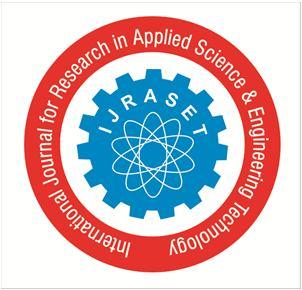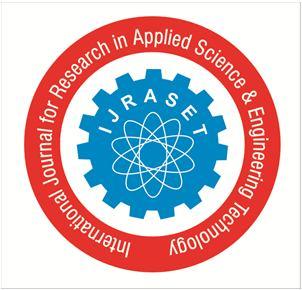
3 minute read
International Journal for Research in Applied Science & Engineering Technology (IJRASET
from Back Propagation
by IJRASET

ISSN: 2321-9653; IC Value: 45.98; SJ Impact Factor: 7.538
Advertisement
Volume 11 Issue IV Apr 2023- Available at www.ijraset.com
The aforementioned procedure was described for a single node or perceptron; it must be repeated for all nodes and updated with new weights. It is necessary to recalculate the mistake with the new weights until it is negligible.
VII. BACK-PROPAGATION ALGORITHM TRAINING
An input pattern and a desired or target output pattern comprise a finite number of pattern pairs used in supervised training for the feed forward back-propagation network. The input layer displays an input pattern. The neurons pass the pattern activations in this area.to the neurons in the following layer, which is a buried layer. The activations of the hidden layer neurons are dictated by the weights and the inputs, and the outputs are obtained by employing a bias and maybe also a threshold function. The output neurons receive these hidden layer outputs as inputs, and the output neurons process the inputs using a threshold function and an optional bias. The activations from the output layer control the network's overall output. The pattern calculated and the A function of this inaccuracy is calculated for each component of the input pattern, and then the weights of connections between the hidden layer and the output layer are adjusted.
The connection weights between the input and hidden layers are calculated in a manner akin to that of the output error. With each pattern pair assigned for network training, the process is repeated. Cycles or epochs refer to each iteration of all training patterns. Once the mistake is within the required tolerance, the operation is repeated as many times as necessary. The determined output error at the output layer is multiplied to obtain the adjustment for a neuron's threshold value. the output neuron and the learning rate parameter that were used in this layer's weight adjustment calculation. A Back-Propagation network can be tested on a second set of inputs to assess how well it detects untrained patterns after learning the proper classification for a set of inputs from a training set. Hence, the network's ability to generalise is crucial when using back-propagation learning.
VIII. APPLICATIONS ON BACKPROPAGATION
Classification Issues: Currently, the goal is to determine if a particular "information point" belongs in Class 1, Class 2, or Class 3. The neural system is prepared to find the example when irregular focuses are assigned to a particular class. When planning is complete, it will apply what it has learned to precisely group new focuses.
Functional Approximation: Currently, the organisation makes unreliable estimates of a particular capacity. The goal is to find the real example, and it is encouraged with all the details. The system accurately measures the estimation of the gaussian capacity after preparation (underneath).
Time-Series Forecasting: Now, the goal is to build a neural network that can predict a worth based on a piece of provided timearrangement information (for example, financial exchange forecast dependent on given patterns). The neural system's contributions must be refactored in chunks in order to advance this problem, and the output will be the next piece of information that comes right after that one (see beneath).

ISSN: 2321-9653; IC Value: 45.98; SJ Impact Factor: 7.538
Volume 11 Issue IV Apr 2023- Available at www.ijraset.com
IX. CONCLUSION
A supervised learning neural network model that is widely used in numerous engineering sectors worldwide is the back-propagation neural network (BPNN). While being widely used in the most useful ANN applications and performing rather well, it has certain issues delayed convergence and convergence to local minima are issues. Because of this, applying artificial neural networks to complex issues is quite difficult.
In this article, we've demonstrated how a backpropagation neural network works well when dealing with big data sets. By altering the, the performance can be the quantity of hidden neurons and the rate of learning. It takes a long time to train on a large quantity of data because of its iterative training and gradient-based training, which are both more slower than necessary. We cannot claim that there is a network out there for every type of database. Continue testing your data on various neural networks to discover which one suits your data the best.
References
[1] J. Kelly, Henry Arthur, and E. Bryson deduced the fundamental concept of incessant backpropagation in relation to the control theory (1961).
[2] A multi-orchestrate dynamic system improvement method was presented by Bryson and Ho (1969).
[3] Hopfield brought his neural framework concept (1982).
[4] Backpropagation received support thanks to the work of David E. Rumelhart, Geoffrey E. Hinton, and Ronald J. Williams (1986).
[5] Wan was the first person to use the backpropagation approach to win a stellar example acknowledgement contest (1993).
[6] Budiharjo S. Triyuni W. Agus Perdana, and H. Tutut, “Predicting tuition fee payment problem using backpropagation neural network model,” (2018)
[7] M. Huan, C. Ming, and Z. Jianwei, “Study on the prediction of real estate price index based on hhga-rbfneural network algorithm,” International Journal of u - and e-Service, Science and Technology, SERSC Australia, ISSN: 2005-4246 (Print); pp.2207-9718 (Online), vol.8, no.7, July, (2015) DOI: 10.142 57/ijunnes st.2015.8.7.11.
[8] Muhammad, A. Khubaib Amjad, and H. Mehdi, “Application of data mining using artificial neural network: survey,” International Journal of Database Theory and Application, vol.8, no.1, (2015) DOI: 10.14257/ijdta.2015.8.1.25.

[9] P. Jong, “The characteristic function of CoreNet (Multi-level single-layer artificial neural networks),” Asia- Pacific Journal of Neural Networks and Its Applications, vol.1, no.1, (2017) DOI: 10.21742/AJNNIA.201 7.1.1.02
[10] L. Wei, “Neural network model for distortion buckling behaviour of cold-formed steel compression members,”Helsinki University of Technology Laboratory of Steel Structures Publications16, (2000)
[11] The concept of Back-Propagation Learning by examples from the http://hebb.cis.uoguelph.ca/~skremer/Teachin g/27642/BP/node3.html


